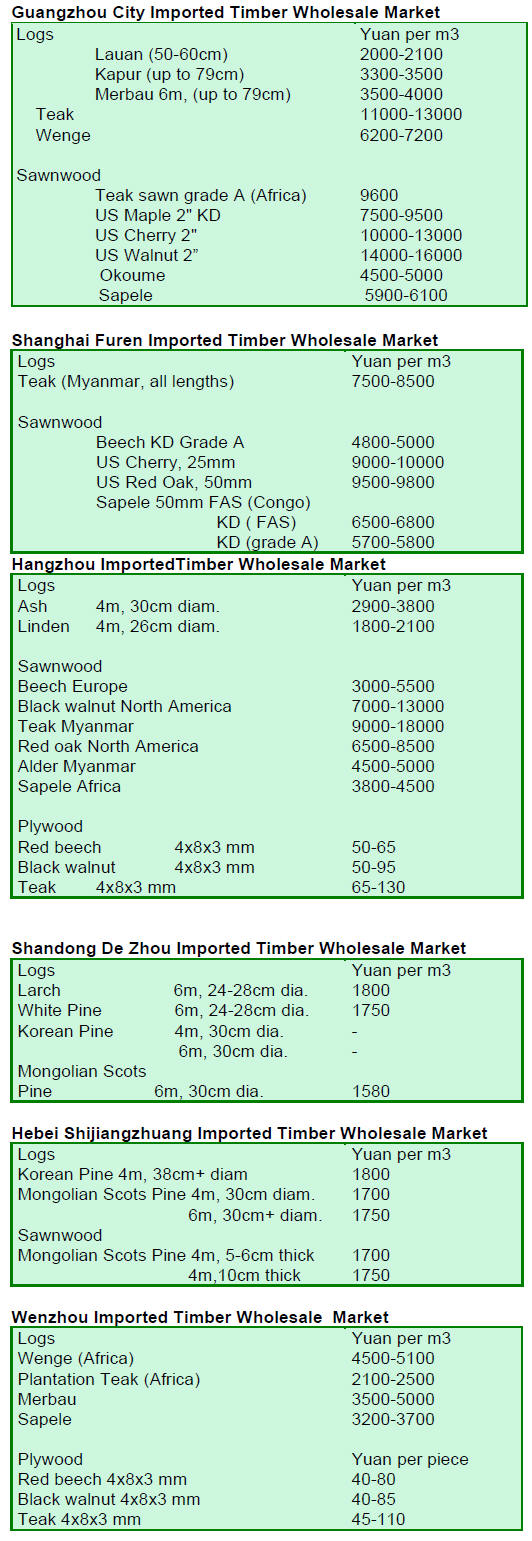US Dollar Exchange Rates of 15th December 2011
China Yuan 6.3560
Report from China
Interim results of national inventory show expansion
of forest area
National forest inventories are carried out every five years
in China and to-date seven inventories have been
implemented.
The eighth forest inventory was started in 2009. In 2010
the State Forest Administration completed preliminary
investigations in seven provinces, Shanxi, Liaoning,
Heilongjiang, Jiangsu, Guangxi, Guizhou and Ningxia.
The results just released show that the area available for
forest plantations increased by 1,696,600 ha while the
conversion of forest land to non forest use fell by 14%.
Overall the forest area in the seven provinces increased by
3.94 million ha.
The growing stock rose by 325.63 million cu.m and the
growing stock in high forest increased by 2.36 cu.m per
ha. Contracted forest lands, forested lands and plantations
for operation by individuals increased from 13%, 15% and
17% at the last count to 34%, 40% and 71% in the recent
inventory.
The results also indicate that the average growing stock
per ha in high forests in the six provinces is only 70.6
cu.m, 15.3 cu.m lower than the 85.9 cu.m national
average.
Guangdong Province links investment in processing to
investment in raw material supply
As of September this year, Guangdong Province began the
implementation of í░Administrative Regulations on
Operation, Processing and Transportation of Timberí▒.
This marked a further development to regulate the timber
supply chain through provincial regulations.
The changes are contained in thirty two articles in the
Regulations which define timber and management
responsibilities and streamlines requirements for permits
to conduct timber operations and processing.
At the same time, the Regulations define the legal
responsibility of each stakeholder and provide for a
monitoring and policing system for timber transportation.
According to the Regulations, primary processing timber
enterprises with an annual production capacity of over
10,000 cu.m can only be established after a forest
inventory and planning process has been completed.
A feasibility study on raw material supply is required this
must be approved by the provincial forestry authority.
Also within the Regulations applications for a license to
establish a primary timber processing plant with an annual
production capacity of over 30,000 cu.m, must include
provision for the creation of forests which can supply 50%
of the raw materials need by the plant.
The Regulations prohibits institutions or individuals
engaged in processing of timber from operating without a
certificate; operation and processing of timber outside the
scope and size prescribed in the license; operation and
processing of timber without legal raw material supply,
purchase of timber from forest areas without permits.
Analysts believe that these Regulations will promote the
protection of forest resources and encourage efficient
management and operation of timber enterprises in
Guangdong Province.
Diversification of log sources benefits New Zealand
and N. American suppliers
Due to the high cost of Russian logs, which now attract an
export tariff, Chinese importers are sourcing more logs
from New Zealand and North America. In first nine
months of this year, China imported some 3.61 million
cu.m of logs from the US, up 107% from the same period
2010.
Imports from Canada totalled 1.76 million cu.m (up
137%) while imports from New Zealand reached 6.18
million cu.m (up 42%). Imports from these two countries
accounted for around 36% of the total logs imports into
China.
In contrast, log imports from Russia plummeted and the
ratio of imported Russian logs to Chinaí»s total logs
imports fell from 43% to 34%. However, despite the
increased cost Russia remains the largest supplier of logs
to China.
According to analysts, the reasons behind the changing log
supply are that firstly Russia introduced the export tax on
logs which suppliers passed on to importers resulting in
increased costs. Secondly, Chinaí»s imports of logs are
mostly coniferous timbers and supplies from the various
sources can be substituted for each other in most end-uses.
The US is one of the most important markets for China
and Chinese companies know that by using American
timbers they will be more likely to be able to satisfy the
US consumer.

íí
|